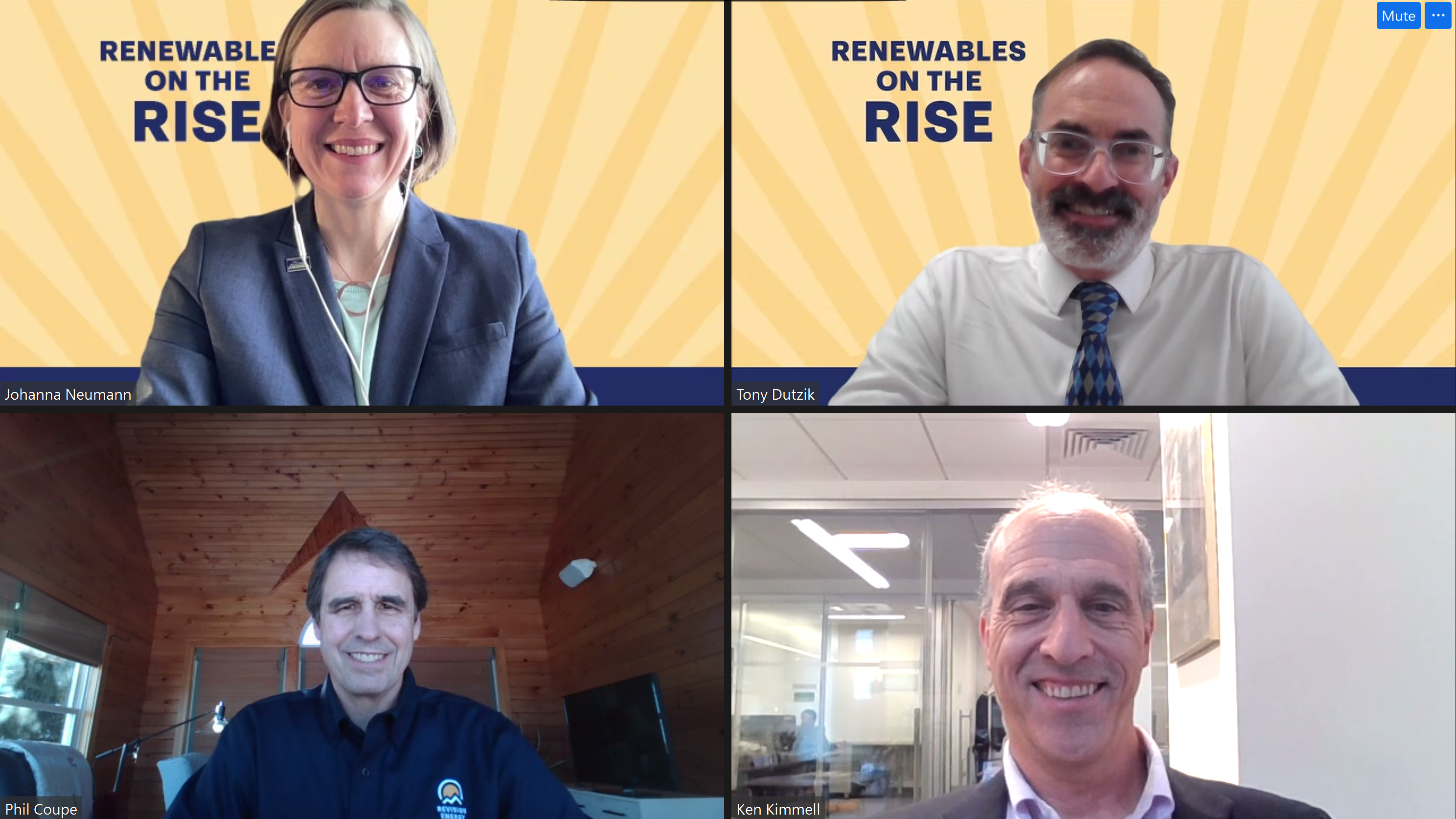
Key takeaways from Renewables on the Rise: Success Stories
Success Stories webinar spreads inspiration; gathers advocates and industry experts together to discuss future of clean energy

Renewable energy is on the rise across the nation, and Environment America Research & Policy Center is keeping track and sharing the good news.
On January 17th, 2024 Johanna Neumann, the Senior Director of the Campaign for 100% Renewable Energy kicked off a webinar, Renewables on the Rise: Success Stories by summarizing renewable energy progress across the U.S. over the past decade before introducing guest speakers Kenneth Kimmell, Chief Development Officer for Offshore Wind Development at Avangrid, and Phil Coupe, Co-founder of ReVision Energies.
Guest speakers Coupe and Kimmell discussed progress on offshore wind and other renewable energy sources and Frontier Group’s Tony Dutzik gave a tour of the Renewables on the Rise Dashboard. To close out the webinar, Neumann shared resources including the Clean Energy Home Toolkit with tips, guides and resources for consumers looking to take advantage of federal tax credits to power their lives with renewable energy. You can read below for key takeaways from the webinar and watch the recording here.

Recording of Renewables on the Rise: Success Stories webinar
Key Takeaways
Renewable energy is on the rise
Phil Coupe shared his perspective that “To enhance America’s energy independence, resilience and cost-savings, the most patriotic thing anyone can do is to reduce fossil fuel consumption through energy efficiency measures, renewable energy and storage.”
And America is full of patriots, all over, who agree and fight for renewable energy. Without these voices, we would not see as much progress as we have seen so far. And, we can physically see the progress as renewables are on the rise, literally being constructed, from coast to coast. One such physical example is America’s first utility-scale offshore wind farm, up and running off the coast of Massachusetts, offering concrete progress toward a future that runs on renewable energy.
The clean energy transition is advancing much faster than most people are aware of.Phil Coupe
Founder, Revision Energy

Coupe shared many concrete examples of advances in clean renewable technology, including battery storage options, electric vehicles, heat pumps, and a long list of other technological advances that help us use energy from the sun, wind and earth more efficiently. There are even electric excavators and electric dump trucks available to use for construction sites that never even need to be charged.

Coupe and Kimmell cited other progress we have made towards a world which runs on clean energy, including revitalizing sites that used to host coal-fired power plants that are now becoming hubs for clean energy technologies, gas stations that are shifting to electric vehicle charging stations, and more.
The panelists not only shared specific examples, but also touched on the big picture. Neumann shared that America produces more than 3 times as much energy from the wind, sun and earth as it did in 2013. Neumann also walked through renewable energy progress over the past decade for six key clean energy technologies.
Six ways clean energy is growing in America
- America produced enough wind energy to power 41 million typical homes in 2022 – 2.6 times as much wind energy as in 2013.
- America produced enough solar energy to power 19 million homes in 2022 – nearly 12 times as much solar energy as in 2013.
- In 2022, America had 8.9 gigawatts of battery energy storage, 60 times as much as in 2013
- Energy efficiency improvements installed in 2021 will save 300 terawatt-hours of power over their lifetimes – enough to power 28 million homes for a year.
- Americans bought 925,000 plug-in electric vehicles in 2022 – a more than 10-fold increase from 2013.
- The number of electric vehicle chargers nationwide exceeded 151,000 – a nearly 18-fold increase from 2013.

Renewables On The Rise Dashboard
America has vast untapped renewable energy potential
America has abundant renewable energy resources, from rays of sunshine raining down across the nation’s rooftops to wind sweeping over our plains and coastlines. These resources never run out, and are bountiful across the United States.
Neumann explained that the total untapped potential of solar energy is equivalent to 284 million GWh, and total wind energy potential is 40 million GWh, coming together to reach a combined potential of 324 million GWh. America’s renewable energy potential dwarfs current energy needs. In 2020, the US used 3.7 million GWh of electricity, a tiny fraction out of our renewable energy potential.
Kimmel commented on how much potential there still is during the webinar.
There is tremendous, tremendous promise in offshore wind.Ken Kimmell
Chief Development Officer, Avangrid

He continued to note that even with the great promise and potential available in offshore wind capacity, the industry and electricity source has faced and still faces great challenges. “No one ever said that addressing climate change would be easy, and offshore wind—a centerpiece of the clean energy transition—has faced many challenges over the last two years.” said Kimmell.
He continued, “However, with companies like Avangrid successfully building the nation’s first utility scale offshore wind project, and leaders in states across the northeast and mid-Atlantic going full speed ahead, the future of offshore wind—and our transition to renewable energy—is bright.”
Reaching America’s renewable energy potential requires overcoming obstacles
How do we overcome the inevitable obstacles to growing renewable energy? Neumann explained that supporters of renewable energy can employ a virtuous cycle to drive even more clean energy adoption. This cycle often starts by setting goals that lead to action and success, which breeds confidence and can be leveraged into greater ambition and the next set of goal-setting. In other words, when it comes to clean energy, success begets more success.

That being said, there are challenges that stand in the way of rapid renewable energy growth. Addressing these challenges can be important for overcoming them to continue this virtuous cycle.
Kimmell identified the following challenges to offshore wind:
- Potential changes in federal administration and policy which help bolster the wind market
- Economic conditions which may make building wind farms more expensive
- BANANA (which is an acronym for the phrase Build Absolutely Nothing Anywhere Near Anyone) sentiment
Kimmell noted that it will be important to continue to advocate for the policies and practices which helped today’s offshore wind farms get off the ground and pointed to four key drivers that have led to today’s offshore successes, including requiring state policy makers to create a way of procuring offshore wind and setting state-level mandates to purchase power created from offshore wind.
You can support efforts to grow renewable energy by taking action below.
Topics
Authors
Emily Mason
Advocate, Environment North Carolina Research & Policy Center
Emily advocates for cleaner air, water, clean energy and protecting wildlife and wild places in North Carolina. Emily lives in Cary, North Carolina, where she enjoys trying new recipes and kayaking.
Johanna Neumann
Senior Director, Campaign for 100% Renewable Energy, Environment America Research & Policy Center
Johanna directs strategy and staff for Environment America's energy campaigns at the local, state and national level. In her prior positions, she led the campaign to ban smoking in all Maryland workplaces, helped stop the construction of a new nuclear reactor on the shores of the Chesapeake Bay and helped build the support necessary to pass the EmPOWER Maryland Act, which set a goal of reducing the state’s per capita electricity use by 15 percent. She also currently serves on the board of Community Action Works. Johanna lives in Amherst, Massachusetts, with her family, where she enjoys growing dahlias, biking and the occasional game of goaltimate.
Find Out More

Which 10 American retailers can lead the way on rooftop solar?

More rooftop solar, less red tape

Unlocking America’s rooftop solar potential


